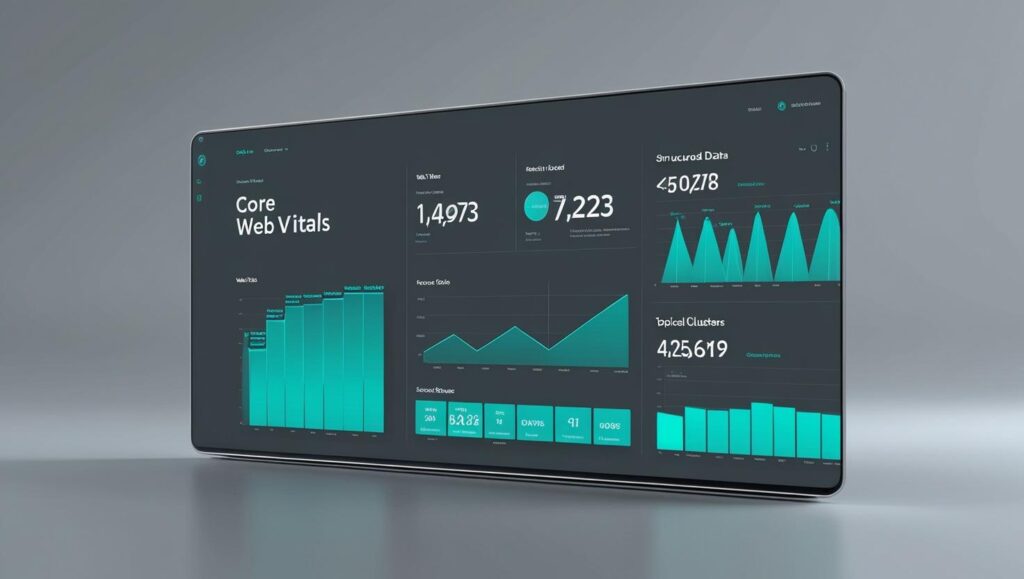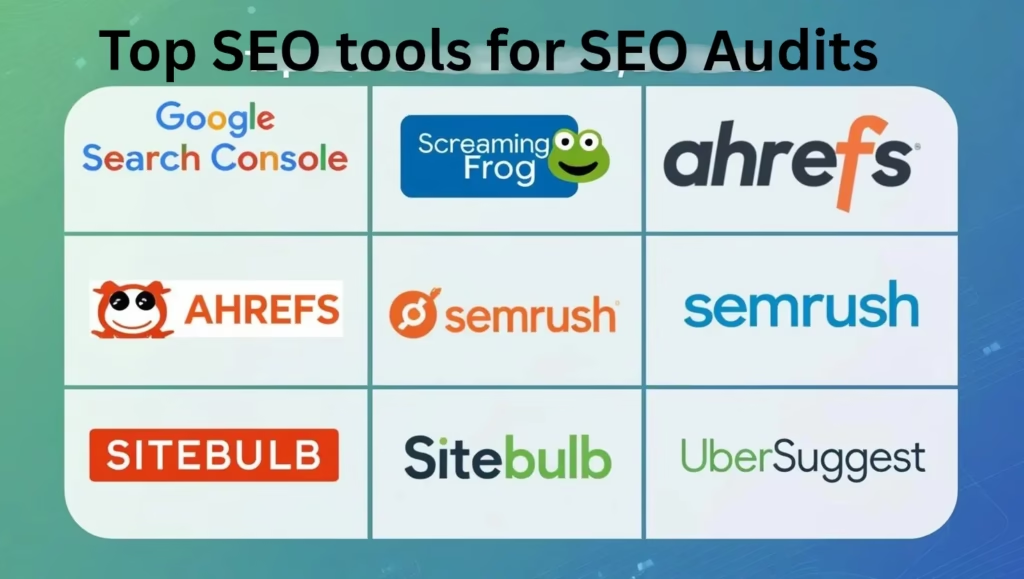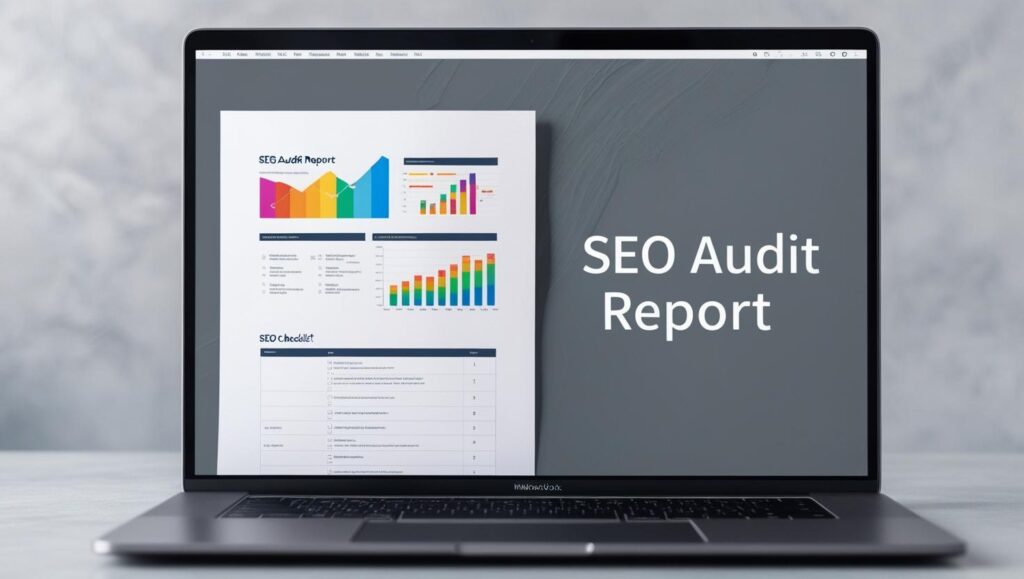How to Do an SEO Audit: Step-by-Step for Beginner
To do an SEO audit, start by analyzing your website’s technical health (site speed, mobile-friendliness, HTTPS, crawlability), then review on-page SEO (titles, meta descriptions, headers, content quality), check for broken links, assess keyword rankings, and evaluate your backlink profile. Tools like Google Search Console, Google Analytics, Ahrefs, SEMrush, and Screaming Frog can help simplify this process.
An SEO audit is like a full diagnostic scan for your website. It helps uncover hidden issues—like slow page speeds, broken links, poor keyword targeting, or technical SEO problems—that could be silently hurting your site’s visibility on search engines like Google.
In this comprehensive guide, we’ll walk you through how to do an SEO audit from start to finish—even if you’re a complete beginner. You’ll learn which tools to use, how to interpret your findings, and how to create a downloadable PDF report of your audit. Whether you’re a small business owner, blogger, or marketer, this guide is designed to help you understand and improve your website’s health.
Let’s dive in and explore what an SEO audit really means—and why it’s the first step to unlocking better rankings and more traffic.

- How to Do an SEO Audit: Step-by-Step for Beginner
- What Is an SEO Audit?
- Tools for SEO Audit
- In-Depth Guide to SEO Audit Tools
- 1. Google Search Console – Your Direct Line to Google
- 2. Google Analytics – Understand Your Visitors
- 3. Screaming Frog SEO Spider – Your Technical SEO Scanner
- 4. SEMrush / Ahrefs – Complete SEO Auditing Suites
- 5. PageSpeed Insights – Optimize for Speed
- 6. Ubersuggest – A Simple All-in-One Tool for Beginners
- How to Do an SEO Audit: Full Step-by-Step Guide
- Step 1 – Check Website Crawlability and Indexing
- Step 2 – Perform a Technical SEO Audit
- Step 3 – Analyze On-Page SEO Elements
- Step 4 – Audit Your Website Content
- Step 5 – Review Your Backlink Profile (Off-Page SEO)
- Step 6 – Check Mobile Usability and UX
- Step 7 – Optimize Internal Linking and Site Structure
- Step 8 – Check for Local SEO (If Applicable)
- Step 9 – Make an SEO Audit Report PDF (how to make SEO audit report pdf?)
- Conclusion: Start Auditing Smarter, Not Harder
- Glossary of SEO Audit Terms
What Is an SEO Audit?
An SEO audit is a comprehensive evaluation of your website’s performance in search engines. It identifies weaknesses, errors, and optimization opportunities that may be preventing your site from ranking well on Google or Bing. Think of it as a health checkup—but for your digital presence.
Why Does It Matter?
Search engines use hundreds of ranking factors to determine where your website appears in search results. Even if your content is great, technical problems or poor keyword usage can bury your pages. An SEO audit helps ensure your website is aligned with the latest algorithm standards and delivers a positive user experience.
What Does It Cover?
A proper audit typically reviews the following key areas:
- Technical SEO – checks crawlability, indexability, site speed, mobile usability, and more.
- On-page SEO – evaluates title tags, meta descriptions, headers, keyword usage, and internal linking.
- Content Quality – analyzes originality, readability, relevance, and value.
- Off-page SEO – looks at your backlink profile, anchor text diversity, and domain authority.
- User Experience (UX) – inspects navigation, mobile friendliness, layout, and engagement metrics.
In short, understanding the SEO audit meaning is about realizing that ranking well isn’t just about keywords—it’s about creating a site that both search engines and users can trust and navigate with ease.

Tools for SEO Audit
To perform an accurate SEO audit, you need reliable tools to uncover data, highlight issues, and provide suggestions for improvements. These tools fall into several categories, depending on what aspect of SEO you’re analyzing.
1. Google Search Console
Purpose: Helps monitor, maintain, and troubleshoot your site’s visibility in Google Search.
- Shows indexing issues, crawl errors, mobile usability, and search performance.
- You can also submit your sitemap and see how Google crawls your site.
2. Google Analytics
Purpose: Tracks how visitors interact with your website.
- Measures bounce rate, average session duration, and traffic sources.
- Identifies high-performing pages and user behavior patterns.
3. Screaming Frog SEO Spider
Purpose: A desktop program that crawls websites and identifies technical and on-page issues.
- Detects broken links, duplicate content, missing metadata, redirects, and more.
- Essential for identifying problems on large sites with many pages.
4. SEMrush or Ahrefs
Purpose: All-in-one SEO platforms for analyzing backlinks, keyword rankings, and site health.
- Track competitors, check domain authority, and audit entire websites.
- Identify toxic links that can hurt your rankings.
5. PageSpeed Insights by Google
Purpose: Tests your page loading speed on both mobile and desktop.
- Gives you performance scores and actionable fixes to improve load times.
- Speed is now a major ranking factor—don’t ignore this tool.
6. Ubersuggest (Beginner-Friendly)
Purpose: Offers a simplified SEO audit with a user-friendly interface.
- Identifies SEO errors, suggests improvements, and tracks keyword rankings.
- Ideal for small websites and beginners.
Using a combination of these tools for SEO audit allows you to gather both high-level data and detailed page-level insights, setting the stage for an effective optimization strategy.

In-Depth Guide to SEO Audit Tools
These tools are the backbone of any successful SEO audit. Let’s explore how each one works, what insights it provides, and how to use it effectively.
1. Google Search Console – Your Direct Line to Google
What It Does:
Google Search Console (GSC) is an essential, free tool that lets you monitor how Google views your website. It shows how your site is performing in organic search and flags issues like crawling errors, indexing problems, mobile usability issues, and page experience signals.
How It Helps in an SEO Audit:
- Crawl Errors: Find URLs that Googlebot couldn’t access.
- Index Coverage: See which pages are indexed and why some are excluded.
- Search Performance: Discover which queries are driving traffic and what your average rankings are.
- Sitemaps: Submit XML sitemaps for faster indexing.
- Mobile Usability: Check how your site performs on mobile devices.
- Core Web Vitals: Get performance data on loading speed, interactivity, and visual stability.
How to Use:
- Go to Google Search Console.
- Add your site name and verify your website using DNS or HTML tag.
- Navigate through:
- Performance to check keywords and rankings.
- Coverage to review indexed pages.
- Experience to monitor Core Web Vitals.
Tip:
Make it a habit to check GSC weekly. It’s your direct feedback loop from Google.
2. Google Analytics – Understand Your Visitors
What It Does:
Google Analytics tracks user behavior—where your visitors come from, what they do on your site, and where they drop off.
How It Helps in an SEO Audit:
- Bounce Rate: High bounce rates may indicate poor user experience or irrelevant content.
- Session Duration: Helps determine if users are engaging with your content.
- Top Pages: Identifies which content is working best organically.
- Traffic Channels: See how much of your traffic comes from organic search.
- Goal Completions: Understand which SEO-driven pages lead to conversions.
How to Use:
- Go to Google Analytics.
- Navigate to Acquisition > Traffic > Source/Medium to see how organic traffic performs.
- Use Behavior > Site Content > All Pages to analyze user behavior on individual URLs.
- Check Conversions if you’ve set up goals (like form submissions or downloads).
Tip:
Use Google Analytics alongside Search Console for a complete view of both search performance and on-site engagement.
3. Screaming Frog SEO Spider – Your Technical SEO Scanner
What It Does:
Screaming Frog is a desktop crawler that scans your website like a search engine. It mimics how bots crawl your pages and provides a massive amount of technical SEO data.
How It Helps in an SEO Audit:
- Broken Links: Find 404 errors that hurt user experience and SEO.
- Redirect Chains: Detect inefficient redirect loops.
- Missing Meta Tags: Identify missing or duplicate title tags and meta descriptions.
- Page Depth: Check how many clicks deep your content is—important for crawlability.
- H1 Tags and Canonicals: Spot SEO mistakes in your HTML structure.
How to Use:
- Download Screaming Frog from screamingfrog.co.uk.
- Enter your website URL and start the crawl.
- Use the tabs to explore:
- Internal links
- Response codes
- Page titles & meta descriptions
- Images and duplicate content
Tip:
Use the free version for up to 500 URLs. For larger sites, the paid version is worth the investment.
4. SEMrush / Ahrefs – Complete SEO Auditing Suites
What They Do:
These are premium, all-in-one SEO platforms that perform in-depth audits, keyword tracking, backlink analysis, and competitive research.
How They Help in an SEO Audit:
- Site Audit Tools: Identify over 100+ technical SEO issues.
- Backlink Analysis: Examine referring domains, anchor text, and link toxicity.
- Keyword Rankings: Track changes in organic positions.
- Competitor Comparison: See where competitors are outranking you—and why.
- Content Gap Analysis: Discover keywords you’re missing out on.
How to Use:
- Create an account at SEMrush or Ahrefs.
- Run a Site Audit by entering your domain.
- Use the dashboard to view issues and recommendations by category (crawlability, performance, content, etc.).
- Use the Backlink Tool to disavow toxic backlinks or acquire new ones.
- Track keyword movements in Position Tracker.
Tip:
If you’re on a budget, start with a 7-day free trial. You can export all your findings during that time.
5. PageSpeed Insights – Optimize for Speed
What It Does:
Google’s PageSpeed Insights measures how fast your website loads on both mobile and desktop. Since speed is a ranking factor, this tool is crucial for audits.
How It Helps in an SEO Audit:
- Performance Scores: Out of 100, based on core metrics like LCP (Largest Contentful Paint).
- Real-World Field Data: Shows how actual users experience your site.
- Recommendations: Offers suggestions to reduce load time—like compressing images, eliminating render-blocking scripts, and reducing unused CSS.
How to Use:
- Visit PageSpeed Insights.
- Enter a page URL and hit “Analyze.”
- Review the Lab Data and Opportunities sections.
- Fix the issues listed to improve performance.
Tip:
Prioritize mobile performance. Google’s Mobile-First Index means your mobile version determines your rankings.
6. Ubersuggest – A Simple All-in-One Tool for Beginners
What It Does:
Ubersuggest, created by Neil Patel, is an easy-to-use tool ideal for beginners. It covers keyword research, competitor analysis, backlink audits, and basic site health checks.
How It Helps in an SEO Audit:
- SEO Audit: Quickly scans your site for SEO issues and health score.
- Keyword Suggestions: Provides keyword ideas based on your content.
- Top SEO Pages: Identifies your best-performing pages.
- Backlinks Report: Tracks who’s linking to you and how valuable those links are.
How to Use:
- Go to Ubersuggest.
- Enter your domain or target keyword.
- Use the Site Audit tab to see on-page SEO issues and recommendations.
- Use the Top Pages report to identify which content to optimize or replicate.
Tip:
If you’re not yet ready to invest in Ahrefs or SEMrush, Ubersuggest is a great starting point.
How to Do an SEO Audit: Full Step-by-Step Guide
Conducting an SEO audit might seem overwhelming, but when you break it down into specific steps, it becomes a methodical and rewarding process. Here’s a structured approach to auditing your website like a professional.
Step 1 – Check Website Crawlability and Indexing
Before search engines can rank your site, they must crawl and index it. If your pages are blocked, redirected incorrectly, or orphaned, they won’t appear in search results.
What to Check:
- Can search engines access your pages?
- Are important pages indexed?
- Are there unnecessary URLs indexed (like staging or tag pages)?
How to Audit:
- Use Google Search Console > Index > Pages to see which pages are indexed and why others are excluded.
- Use Screaming Frog to simulate how search engines crawl your website.
- Check your robots.txt and meta robots tags for noindex, nofollow, or disallow directives.
Tools:
- Google Search Console
- Screaming Frog
- URL Inspection Tool
Step 2 – Perform a Technical SEO Audit
Technical SEO ensures your site meets the core requirements of modern search engines for crawling and indexing.
What to Check:
- Site speed and Core Web Vitals
- Mobile responsiveness
- Secure HTTPS connection
- Proper redirection (no chains or loops)
- Clean URL structure
How to Audit:
- Use PageSpeed Insights to evaluate mobile and desktop speed.
- Run a Core Web Vitals report in GSC.
- Check for broken links, duplicate content, and sitemap issues using Screaming Frog or SEMrush.
- Ensure all pages are HTTPS-secured.
Tools:
- PageSpeed Insights
- Google Search Console (Experience tab)
- Screaming Frog or SEMrush
Step 3 – Analyze On-Page SEO Elements
On-page SEO is about optimizing individual pages so they rank higher and earn more relevant traffic.
What to Check:
- Title tags and meta descriptions
- H1-H6 structure and keyword usage
- Keyword optimization (avoid stuffing)
- Internal linking structure
- Image alt text and file sizes
How to Audit:
- Use Screaming Frog to identify missing or duplicate titles and meta descriptions.
- Check H1 tags for each page — there should be only one per page.
- Use Ubersuggest to see keyword usage and get suggestions.
- Review internal linking and add contextual links where needed.
- Use tinyPNG or similar tools to compress images and add proper alt attributes.
Tools:
- Screaming Frog
- Ubersuggest
- Yoast SEO (for WordPress sites)
Step 4 – Audit Your Website Content
High-quality content is the foundation of SEO. Search engines reward pages that provide original, valuable, and comprehensive information.
What to Check:
- Thin or duplicate content
- Keyword relevance and intent match
- Content freshness and update frequency
- Readability and formatting
How to Audit:
- Identify pages with low word count (<300 words) and update or merge them.
- Use Copyscape or Siteliner to find duplicate content.
- Use Google Analytics to find pages with high bounce rates — often a sign of poor content.
- Refresh outdated articles with new stats or insights.
Tools:
- Copyscape / Siteliner
- Google Analytics
- Grammarly / Hemingway Editor (for readability)
Step 5 – Review Your Backlink Profile (Off-Page SEO)
Backlinks are among the top ranking signals for Google. But not all backlinks help—some may even hurt.
What to Check:
- Number of referring domains
- Anchor text diversity
- Toxic/spammy backlinks
- Lost backlinks
How to Audit:
- Use Ahrefs or SEMrush to view all backlinks and assess link quality.
- Look for spammy or irrelevant domains and disavow them using Google’s Disavow Tool.
- Reclaim lost backlinks by contacting the source website.
Tools:
- Ahrefs / SEMrush
- Moz Link Explorer
- Google Disavow Tool
Step 6 – Check Mobile Usability and UX
With mobile-first indexing, user experience (UX) on mobile is a major ranking factor.
What to Check:
- Mobile-friendly layout and responsiveness
- Tap target size (buttons/links)
- Page speed on mobile
- Pop-ups or interstitials that block content
How to Audit:
- Use Google’s Mobile-Friendly Test to assess mobile usability.
- Navigate your site on different devices and screen sizes manually.
- Check for usability errors in GSC under “Mobile Usability.”
Tools:
- Google Mobile-Friendly Test
- GSC Mobile Usability Report
- Browser Dev Tools (Responsive View)
Step 7 – Optimize Internal Linking and Site Structure
A clear, logical structure helps both users and search engines understand your content hierarchy.
What to Check:
- Orphan pages (pages with no internal links)
- Too many or too few links per page
- Deep pages buried in the site architecture
How to Audit:
- Use Screaming Frog to see your internal linking structure.
- Group pages into topic clusters and link from pillar to sub-pages.
- Ensure all important pages are 2–3 clicks from the homepage.
Tools:
- Screaming Frog
- Sitebulb (visual structure maps)
Step 8 – Check for Local SEO (If Applicable)
If you’re a local business, your SEO audit must include local ranking factors.
What to Check:
- Google Business Profile setup
- Local NAP (Name, Address, Phone) consistency
- Local backlinks and citations
- Customer reviews and ratings
How to Audit:
- Search for your business in Google Maps and look at your competitors.
- Use BrightLocal to analyze your local citations.
- Encourage reviews and respond to them actively.
Tools:
- Google Business Profile
- BrightLocal
- Moz Local
Step 9 – Make an SEO Audit Report PDF (how to make SEO audit report pdf?)
After completing your audit, organize all your findings into a structured, downloadable report.
What to Include:
- Executive summary (main issues and opportunities)
- Audit categories (technical, on-page, off-page, UX, content)
- Screenshots and graphs from tools
- Actionable recommendations for each issue
- Priority levels and timelines for fixes
How to Create the Report:
- Use Google Docs or Notion to structure your findings.
- Add images from tools like GSC, Screaming Frog, and Ahrefs.
- Export as a PDF.
- Optionally, create a PowerPoint or Canva presentation for client or team delivery.
Tools:
- Google Docs / Word
- Canva / PowerPoint
- PDF Export Too
Conclusion: Start Auditing Smarter, Not Harder

An SEO audit is not just a checklist — it’s a blueprint for better search visibility. By following this step-by-step guide, you’re not just fixing issues — you’re laying the foundation for a sustainable, long-term SEO strategy.
Whether you’re a small business owner or an SEO professional, auditing your website regularly will help:
- Discover growth opportunities
- Avoid penalties
- Improve UX and engagement
- Stay ahead of competitors
Remember, tools for SEO audit can provide data, but your interpretation and action plan make the difference. Set a schedule — quarterly or bi-annually — and treat your SEO audit like a health check-up.
Lastly, always compile a clear, actionable SEO audit report PDF so stakeholders or clients understand what needs to be done — and why.
If you’re unsure where to start or want a personalized audit, don’t hesitate to consult a professional SEO agency.
Have you ever wonder the cost of SEO service for your website?
Glossary of SEO Audit Terms
1. SEO Audit
An SEO audit is a comprehensive analysis of a website to evaluate how well it is optimized for search engines. It involves reviewing technical SEO, on-page elements, content quality, backlinks, and more. The goal is to identify issues that may be hurting the site’s ability to rank and provide clear solutions for improvement.
2. Crawlability
Crawlability refers to a search engine’s ability to access and navigate your website. If search engine bots (also called spiders) can’t crawl your pages due to restrictions (like in robots.txt or broken links), your content won’t be indexed or ranked.
Think of it like trying to explore a building: if the doors are locked, no one can enter — not even Google.
3. Indexing
Indexing is the process by which search engines store information about your website and its pages after crawling them. Indexed pages are eligible to appear in search results. If a page isn’t indexed, it will not show up on Google — even if it’s well-optimized.
4. Technical SEO
Technical SEO involves optimizing your website’s infrastructure to help search engines crawl, interpret, and index your site efficiently. This includes improving site speed, mobile-friendliness, HTTPS security, structured data, and fixing broken links.
5. Core Web Vitals
Core Web Vitals are a set of metrics introduced by Google that measure real-world user experience:
- LCP (Largest Contentful Paint): How quickly the main content loads.
- FID (First Input Delay): Time taken for the site to respond to the first interaction.
- CLS (Cumulative Layout Shift): How much the content shifts during loading.
A good Core Web Vitals score helps improve rankings and user satisfaction.
6. On-Page SEO
On-page SEO refers to optimizations made directly on your website’s pages. This includes title tags, meta descriptions, headers (H1–H6), keyword usage, internal linking, image optimization, and content structure.
If your website was a book, on-page SEO would be the chapters, headings, and formatting that help readers (and Google) understand the story.
7. Backlink
A backlink is a link from another website pointing to yours. High-quality backlinks from authoritative sites signal to search engines that your content is trustworthy and relevant. Backlinks are a core ranking factor in Google’s algorithm.
8. Disavow Tool
Google’s Disavow Tool lets you tell Google to ignore certain spammy or low-quality backlinks pointing to your site. This is useful if your backlink profile contains harmful links that might hurt your rankings.
9. Mobile-First Indexing
Mobile-first indexing means Google predominantly uses the mobile version of a site for indexing and ranking. If your site is not optimized for mobile devices, your SEO performance will suffer — even on desktop.
10. Meta Tags
Meta tags provide metadata about a web page, such as its title and description. These tags are not visible on the page but appear in search results and influence click-through rates.
- Meta Title: The blue link that appears in search results.
- Meta Description: The short summary under the title.
11. Robots.txt
The robots.txt file gives instructions to search engine bots on which parts of your site they are allowed or disallowed from crawling. A misconfigured robots.txt can block important pages from being indexed.
12. Orphan Page
An orphan page is a webpage that has no internal links pointing to it. If no other page on your site links to it, search engines may not find it, and users won’t navigate to it — resulting in wasted SEO value.
13. Canonical Tag
A canonical tag is used to tell search engines which version of a webpage is the “master” copy. This helps prevent duplicate content issues when the same content exists at multiple URLs (e.g., with tracking parameters or print versions).
14. Alt Text
Alt text (alternative text) is a short description added to images. It helps search engines understand the image content and improves accessibility for visually impaired users. Alt text also plays a role in image SEO.
15. Internal Linking
Internal linking is the process of linking one page of your website to another page on the same domain. It improves crawlability, distributes page authority (link juice), and guides users through your content.
16. Bounce Rate
Bounce rate refers to the percentage of visitors who leave your website after viewing only one page. A high bounce rate may indicate poor content quality, slow loading, or irrelevant traffic.
17. Site Architecture
Site architecture refers to how your website’s content is organized and connected. A clear, shallow structure (where pages are only a few clicks from the homepage) helps users and search engines find content easily.
18. SEO Audit Report
An SEO audit report is a structured document summarizing all the issues found during the audit along with recommendations for fixing them. It is typically shared with clients or teams and often exported as a PDF.
19. SERP (Search Engine Results Page)
SERP is the page displayed by search engines when a user searches for something. It includes organic listings, paid ads, featured snippets, videos, and local results. The goal of SEO is to improve visibility on the SERP.
20. Duplicate Content
Duplicate content refers to blocks of content that appear in more than one location (URL) on the web. This confuses search engines, which may struggle to decide which version to index and rank — possibly lowering your SEO performance

Pingback: How TenzDigital is Redefining Small Business Success with Next-Level Web Design and SEO - Primenewsofindia